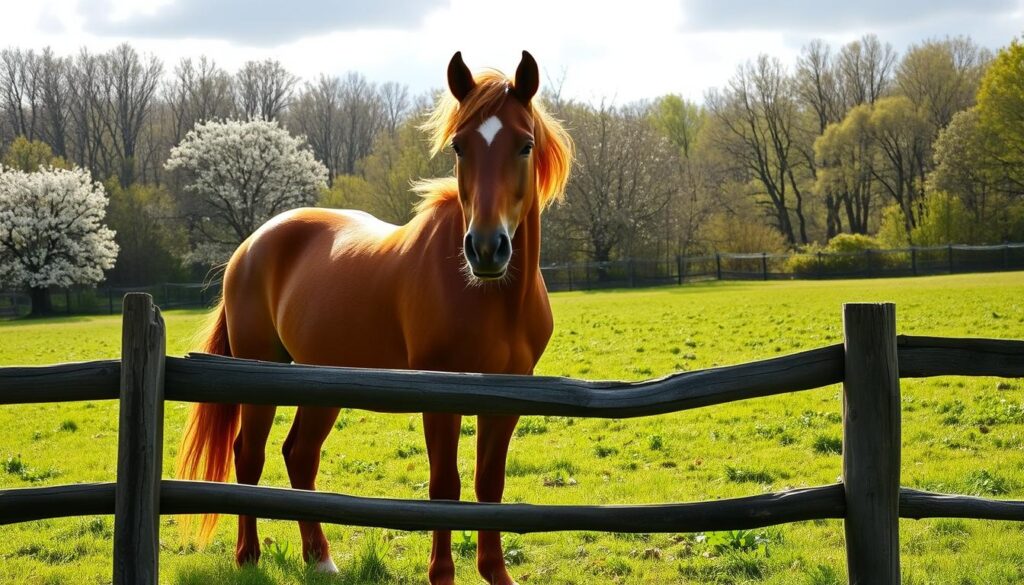Did you know 40% of equine health issues reported in Canada are linked to seasonal changes? As temperatures swing from icy winters to humid summers, these animals rely on owners to adapt their routines. Their coats, diets, and even behavior shift with the weather—and missing these cues can lead to avoidable problems.
Spring brings muddy pastures and fresh grass growth, which may disrupt sensitive digestive systems. Summer demands hydration strategies and shade access to prevent overheating. When winter arrives, maintaining body heat becomes critical—especially with icy ground increasing slip risks.
Natural forage plays a key role year-round. For example, hay quality in colder months supports energy needs, while spring grazing requires gradual introduction. Shelter access also matters: a dry space during rainstorms or windbreaks in snow ensures comfort.
Understanding these patterns isn’t just practical—it’s a lifeline. Let’s explore how to adjust feeding, grooming, and turnout practices to keep your equine partner thriving through every season.
Key Takeaways
- Seasonal shifts directly impact coat growth, digestion, and energy levels.
- Adjust feed quality and quantity based on temperature and activity.
- Provide reliable shelter to protect against extreme weather.
- Monitor water sources to prevent freezing in winter or algae in summer.
- Rotate pastures to manage grazing and reduce mud-related issues.
- Tailor exercise routines to avoid overheating or muscle strain.
Understanding Seasonal Horse Care
What if adjusting your approach could transform how your equine partner thrives year-round? Shifts in temperature and daylight directly influence behavior and metabolism. Recognizing these patterns helps prevent issues like colic or weight fluctuations.
Decoding Behavior and Diet Shifts
Restlessness or sudden weight loss often signals unmet nutritional needs. For example, limited winter turnout may require increased hay portions to maintain warmth. In warmer months, excessive sweating could mean electrolyte supplements are needed.
Simple Health Check Methods
Three tools help track wellness:
- Weigh tapes: Measure girth weekly
- Fat scoring: Check ribs and neck crest
- Mud checks: Monitor skin under wet coats
Rotate pastures to balance grazing and reduce mud. During freezing weather, break ice from water troughs twice daily. A gradual feed transition over 7-10 days prevents digestive upset when seasons change.
Owners should adjust portions based on activity levels. A leisure-riding animal needs 25% fewer calories than one in training. Always provide free-choice salt and clean water—dehydration risks spike in both summer heat and dry indoor winter air.
Spring Horse Care Essentials
Spring transforms paddocks into vibrant spaces but demands smart adjustments. As days lengthen, focus shifts to three priorities: renewing protective layers, optimizing outdoor spaces, and preventing weather-related irritants.

Grooming and Coat Renewal
Daily brushing removes winter undercoat and stimulates blood flow. Use a shedding blade first, then a soft curry comb. Pay attention to mane and tail knots—gentle detangling prevents hair breakage. Bathing too early? Skip it. A damp cloth wipe-down preserves natural oils until temperatures stabilize.
Turnout and Field Management
Rotate grazing areas every 3-4 weeks to let grass recover. Spread manure evenly to fertilize without creating mud hotspots. Install French drains near gates if your region gets heavy April showers. Pro tip: Wait until ground firms up before expanding turnout time.
Managing Mud and Allergies
Three strategies keep paddocks functional:
- Lay gravel pads around feeding stations
- Trim pasture weeds before they seed
- Use dust-free bedding in shelters
For allergy-prone animals, rinse nostrils after dusty rides. Store hay in covered areas to minimize mold spores. Check legs daily for scratches—muddy conditions can cause bacterial skin issues.
Adjust feed gradually as fresh grass emerges. Introduce new forage over 10 days to avoid digestive upsets. Balance exercise with rest periods—sudden activity spikes strain joints after winter downtime.
Summer Horse Care and Turnout Management
When temperatures soar past 30°C, equines lose up to 15 liters of fluid daily through sweat. This makes smart summer management crucial for preventing dehydration and heat-related stress. Focus on three pillars: reliable water access, shaded resting areas, and adjusted activity plans.
Hydration and Shade Considerations
Water availability trumps all other summer priorities. Clean troughs daily to prevent algae growth, and add electrolytes to encourage drinking. Ontario equine veterinarian Dr. Sarah Lemieux notes: “I’ve seen cases where adding a simple salt block increased water intake by 20%.”
Position turnout areas near natural shade sources like trees. For open fields, install three-sided shelters with reflective roofing. Rotate grazing schedules to avoid midday sun exposure.
Maintaining Fitness in Hot Weather
Shift workouts to early mornings or evenings when temperatures drop. Limit intense sessions to 30 minutes, and always check ground surfaces—hot sand can burn sensitive hoof tissue.
Adjust feed to include higher moisture content. Soaked beet pulp or fresh vegetables help maintain hydration. Reduce grain portions if activity levels decrease, but keep forage consistent for digestive health.
Monitor animals for these heat stress signs:
- Flared nostrils during rest
- Skin that stays tented when pinched
- Unusual lethargy after cooling off
Winter Horse Care: Keeping Your Horse Warm and Healthy
Winter transforms equine routines with biting winds and frozen ground. Managing warmth becomes a daily priority, requiring adjustments to feeding plans, shelter setups, and health monitoring. Let’s explore how to balance natural adaptations with practical support during Canada’s coldest months.
Feeding Strategies for Frosty Days
Cold weather boosts energy needs by up to 25%. High-quality hay should form 70% of the diet—its digestion generates internal heat. Introduce grain supplements gradually to avoid digestive shocks. A 1,200-pound animal may need 2.5% more forage daily when temperatures drop below -10°C.
| Hay Type | Energy Content | Best For |
|---|---|---|
| Grass Hay | Moderate | Light activity |
| Alfalfa | High | Senior or underweight |
| Mixed | Balanced | Most adults |
Smart Blanketing and Shelter Solutions
Blankets aren’t always necessary—healthy coats trap heat naturally. Use them only if:
- Shelter access is limited
- Rain soaks through the coat
- Age or health reduces fat stores
Check fit weekly—tight straps restrict movement. Install three-sided shelters with south-facing openings to block north winds. Bedding should stay dry; replace straw weekly.
Hoof Health and Winter Vigilance
Ice buildup in hooves increases slip risks. Apply non-stick wax before turnout. Trim every 6-8 weeks to prevent cracks. Monitor weight monthly using a tape measure across the girth. Quick tip: A slight fat layer over ribs helps maintain body heat.
Nutrition and Feeding Strategies Across Seasons
Proper nutrition fuels 70% of an equine’s health year-round. As grazing patterns shift with weather changes, owners must balance natural forage with targeted supplements. This approach supports energy needs while preventing digestive upsets.
Forage: The Cornerstone of Wellness
High-quality hay or pasture should make up 80-90% of daily intake. Fiber fermentation generates internal heat during winter, while spring grasses provide hydration. Alberta nutritionist Dr. Emily Clark advises: “Think of forage as a thermostat—it naturally regulates body functions across temperature extremes.”
When Supplements Make Sense
Additives fill gaps when local forage lacks nutrients. A soil test reveals mineral deficiencies—common in regions with acidic rain. Consider these three scenarios:
- Winter: Vitamin E boosts immune function
- Summer: Electrolytes replace lost minerals
- Spring: Probiotics support gut transitions
Track weight weekly using a tape measure across the girth. Pair this with body condition scoring—aim for a 5 on the 1-9 scale. Ribs should feel smooth under light pressure, not sharp or buried.
Adjust portions when temperatures swing. For every 10°C drop below freezing, increase hay by 15%. Reduce concentrates if turnout time decreases. Always transition feeds over 7-10 days to avoid colic.
“Owners who measure first and adjust second see 30% fewer weight issues,” notes Dr. Clark.
Keep water sources ice-free in cold months and algae-free in summer. Pair consistent monitoring with gradual changes—your partner’s shiny coat and steady energy will show you’ve nailed it.
Practical Exercise and Hoof Care Tips
Keeping equines active and comfortable through weather shifts requires smart planning. Whether battling summer heat waves or navigating icy trails, small adjustments to routines prevent injuries and stress. Let’s break down three core strategies for year-round wellness.

Safe Riding Practices in Extreme Weather
Check footing before riding—muddy or frozen ground increases slip risks. Use studded boots for icy trails, and avoid midday rides when temperatures peak. Lightweight tack reduces sweat buildup in summer, while moisture-wicking saddle pads help in humid conditions.
Adjust workout intensity based on weather alerts. During heatwaves, shorten sessions to 20 minutes and walk on shaded paths. In deep snow, stick to packed trails to avoid muscle strain.
Regular Hoof Picking and Maintenance
Snow and mud love to hide in hooves. Clean them daily with a sturdy pick to prevent “snowball” buildup that strains tendons. Apply non-stick wax during winter to repel ice chunks. Pro tip: Check for cracks weekly—early detection avoids costly treatments.
Trim schedules matter. Most animals need attention every 6-8 weeks, but wet seasons may require more frequent visits. Pair trims with body condition checks to spot weight changes early.
Adapting Exercise Routines to Seasonal Changes
Turnout time counts as exercise! Rotate between paddocks and arenas to keep minds engaged. In freezing months, hand-walk for 15 minutes if riding isn’t possible. Summer? Try dawn trail rides to beat the heat.
Watch for these signs of overexertion:
- Labored breathing after cool-down
- Stiffness lasting over 24 hours
- Reluctance to move forward
Canadian equine therapist Mia Tremblay notes: “Consistency trumps intensity. Ten minutes of controlled movement daily does more than sporadic hour-long sessions.”
Conclusion
Year-round equine wellness demands attention to nature’s rhythms. By aligning feeding plans, shelter setups, and activity routines with each season’s challenges, owners create resilient partners ready for anything.
Key strategies stand the test of time: adjust hay quality in freezing months, provide shaded turnout during heatwaves, and monitor hydration daily. Regular body checks catch subtle changes before they escalate—measure girth weekly and track muscle tone.
Protective measures matter. Use breathable blankets only when necessary, and maintain dry bedding through wet weather. Rotate pastures to balance grazing while preventing mud-related skin issues. Don’t forget those hooves—consistent picking and trimming prevent snowball buildup or cracks.
Your action plan? Start today. Consult local veterinarians about region-specific needs, then tweak one routine at a time. Share your experiences with fellow enthusiasts—collective wisdom strengthens entire herds.
Ready to refine your approach? Reach out through our contact page for personalized advice. Together, we’ll ensure every gallop through spring blooms and winter frosts remains joyful and safe.

